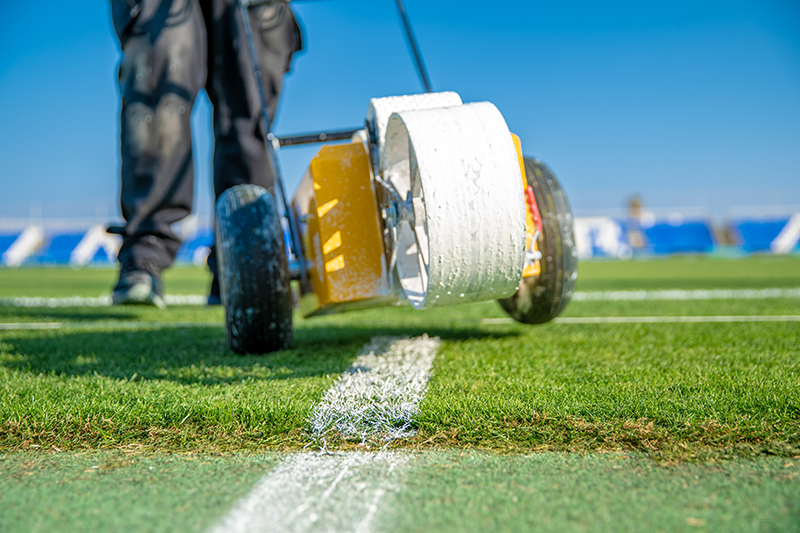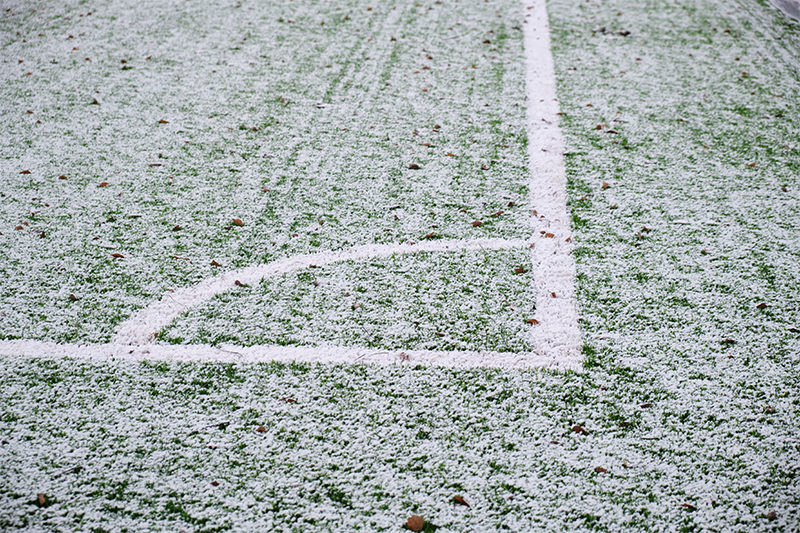Last Updated on: 17th September 2024, 09:51 am
Football Pitch Maintenance
The Basics of Pitch Care
Football pitch maintenance is important because a decent pitch is one of your greatest assets. Although, tight budgets and rising costs are making it more challenging for amateur clubs. Some clubs might be lucky enough to have a groundskeeper for their pitch maintenance but what about the rest?
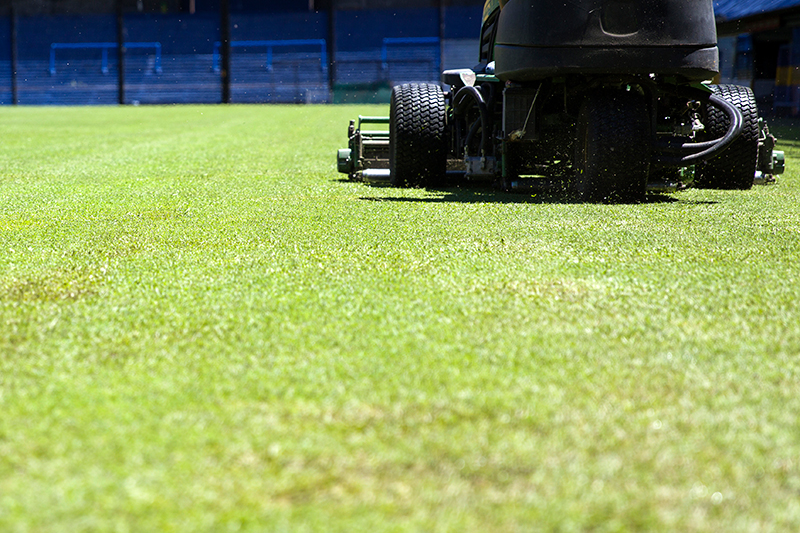 The Basics of Pitch Care
The Basics of Pitch Care
The key to good football pitch maintenance is providing regular care and attention. You want to ensure the surface is safe and playable for matches and training sessions.
Ultimately, the tasks you’ll need to perform will depend on the time of year. In the off-season, you’ll need to focus on repairing the pitch and getting ready for next season. During the playing season, you need to keep the pitch in the optimum condition for play. This includes regular mowing, line marking and keeping the surface clear.
Equipment Needed
What you have to hand will depend on your budget but there are some standard products that will be helpful.
- Lawn Mower: A sturdy lawn mower, preferably a rotary or cylinder mower, for regular grass cutting.
- Line Marking Machine: To keep the pitch lines crisp and clearly visible.
- Fertilizer Spreader: For even distribution of fertilizers.
- Aerator: To alleviate soil compaction and promote better water and air circulation.
- Scarifier: To remove thatch and moss from the pitch.
- Seed Spreader: For overseeding to maintain grass density.
- Irrigation System: To ensure consistent and adequate watering.
- Rake and Leaf Blower: For debris and leaf removal.
- Topdressing Material: A mix of sand and soil to improve pitch quality. Get advice from a professional before choosing a topdressing.
- Weed Killer: For controlling weeds that can disrupt the grass.
- Goalpost Maintenance Tools: Spanners, wrenches, and touch-up paint.
- Safety Equipment: Gloves, safety goggles, and ear protection.
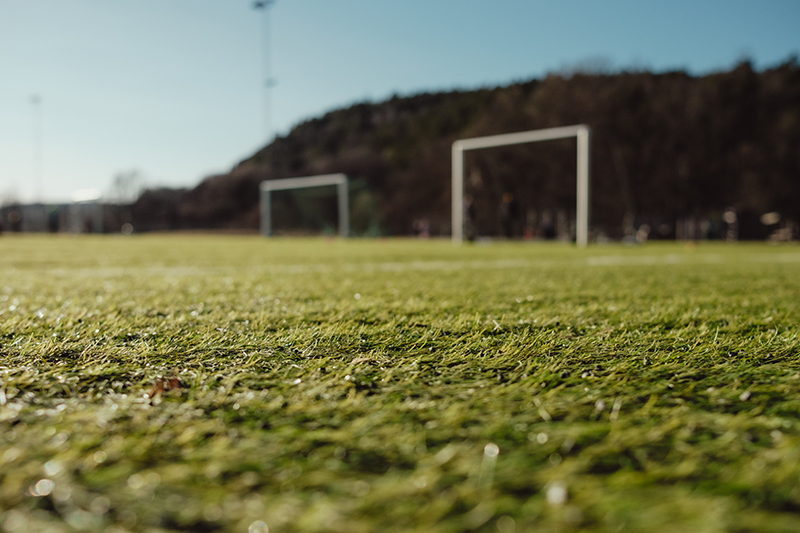 Off-Season
Off-Season
Depending on how long you have, you’ll probably want to start looking at the pitch as soon as the season is over. The first stage of pitch renovations is scarification to clean out dead material. Then you’ll want to start spiking or slitting to improve the aeration, root development and drainage. This will help prepare the pitch before you start overseeding.
Overseeding
Overseeding involves spreading new seeds over the existing grass. This helps to improve the quality, density and overall appearance of your pitch. Remember, it’s not recommended to play on the pitch for about 6 weeks after overseeding because you need to leave time for root development.
Overseeding offers improved grass coverage and makes the grass more resilient. So, it will create a better playing surface. It can also prevent disease because thick grass is less prone. This aspect of pitch maintenance isn’t just essential for preventative maintenance but it helps reduce the need for expensive repairs.
Pitch Maintenance Tasks
Over the year, your major pitch maintenance tasks will change. Some of the major tasks to consider are:
- Aeration: An operation that helps to ventilate the soil, improve drainage and encourage root development. Air in the soil is replaced by air from the atmosphere. You can use a hand fork for small areas but full pitches could require more heavy-duty equipment.
- Divoting: After matches and training, you’ll need to recover and place divots. Lightly fork the area around the divot to alleviate surface compaction and smearing. For lighter soils, you should lightly rake the surface before replacing the divot.
- Irrigation: Needed to maintain grass plant health and structure. Apply water with an automated system or manual sprinklers. Adjust your irrigation system according to changing weather conditions. Ensure that the pitch receives adequate water to prevent it from drying out but without it becoming waterlogged.
- Line Marking: Mark the pitch lines accurately and consistently before each game or training session. Ensure that the lines are straight and adhere to official regulations regarding line spacing and dimensions.
- Mowing: Keeping the height consistent creates the best playing surface and ensures pitch lines can be seen clearly. Pitches are traditionally kept at a height of 25-30mm during the playing season.
- Scarification: Used to lift grass and remove dead grass and rubbish from the surface. The pitch should be raked manually or with a scarifier.
- Topdressing: Topdressing is used to help restore surface levels and improve surface drainage with the addition of sand. It should be distributed on the pitch before being brushed in. The topdressing used will depend on the structure of your soil and what you want to achieve.
For a more detailed overview, check out the Ground Management Association’s Monthly Essentials and Football Pitch Maintenance Calendar.
Pitch Checks
You will need to regularly check the pitch so you are able to spot any problems and sort them out as quickly as possible. These checks will include:
- Pitch Inspection: Regularly inspect the pitch for issues like drainage problems, pests, or diseases. Address these issues promptly to prevent them from worsening.
- Debris Removal: After games or training sessions, use a rake and leaf blower to remove leaves, debris, and litter from the pitch.
- Goalpost Maintenance: Inspect and maintain goalposts and nets regularly. Ensure they are securely anchored and in good condition to prevent accidents.
- Goalmouth and Centre Circle Care: These areas often experience the most wear so will need to be regularly checked throughout the season.
- Safety Precautions: Prioritise player safety by regularly checking for hazards like holes, sharp objects, or uneven ground.
- Weed Control: Keep an eye out for weeds and apply weed killer as necessary to prevent them from spreading.
Carrying out these regular checks will make it easier keep on top of you pitch maintenance because you will spot any issues before they get too bad. They also mean that you can ensure that the pitch is in the best playing conditions. This will keep the players safe and offer the best surface for the ball.
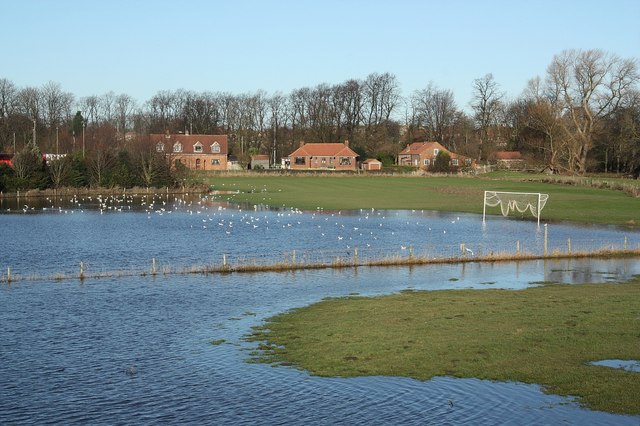 The Weather
The Weather
As we know, British weather is unpredictable so your pitch maintenance will also depend on the weather. To properly maintain your pitch, you’ll always need to be aware of the weather. Have a plan in place for emergencies and prepare for anything. You’ll want to adjust your pitch maintenance schedule depending on the weather otherwise you might end up causing damage.
Moisture Levels
Alter your irrigation plan if you experience extreme rainfall or extreme dry spells. It’s also important that the moisture content is high enough to create healthy turf without becoming waterlogged.
Aeration shouldn’t be carried out if the pitch is too wet otherwise it will reduce the drainage potential of the pitch. If there’s been a lot of rain recently or you aren’t sure about the moisture levels of the turf, it’s best not to do anything.
Winter Weather
Snow and frost aren’t harmful to the grass plant and can just be left to melt unless there is an immediate need to clear them. Although, frozen ground is prone to water logging so your pitch won’t necessarily be playable when the snow has melted.
Frost
You’ll need to adjust your pitch maintenance routine when frost hits. Here are our top tips for frosty weather.
- Avoid stepping on the pitch or using any machinery. This could lead to bruising and cause damaged areas. The turf will not recover from this until growth resumes in the spring.
- Ensure that you check all areas of the pitch. Worn areas and bare ground are more susceptible to freezing so you’ll want to make sure these areas are safe.
- Avoid aeration or deep spiking when the air temperature drops because this will make the soil more susceptible to freezing. Cold air can also hit the roots and cause turf stress.
- Avoid using fertiliser when frost is expected.
- Don’t use salt, hot water or other snow-melt products on the turf. They will burn it and most likely kill it.
- Use a frost protection sheet to insulate vulnerable areas, like your goal mouths.
Snow
It can be a lot of work to remove snow from your pitch and snowfalls can be very hard to cope with at a grassroots level. Depending on what equipment you have, you can take some steps to help.
- You can clear light snow pretty easily. For example, by dragging heavy ropes over the surface. Heavy-duty plastic shovels, drag brushes and mats can also be used. Avoid larger equipment because it may damage the soil.
- Larger snowfall will require more hands and time to deal with. If the snowfall is particularly heavy, it is often better to postpone or cancel matches even if it’s not a great outcome.
- You can always line your pitch in a different colour if snow is forecast during a fixture.
Depending on the temperature of the soil when snow falls, there may be a heightened risk of disease. Make sure you keep an eye on your pitch for signs.
Ask the Experts
There is a lot to think about when it comes to pitch maintenance but there are plenty of resources available. There are plenty of video tutorials and technical advice available to help you out. Consider getting specialised training from the GMA’s website or check out Pitch Care for advice and news about pitch maintenance.
Tags: football pitch, football pitch maintenance, football pitch markings, pitch maintenance

